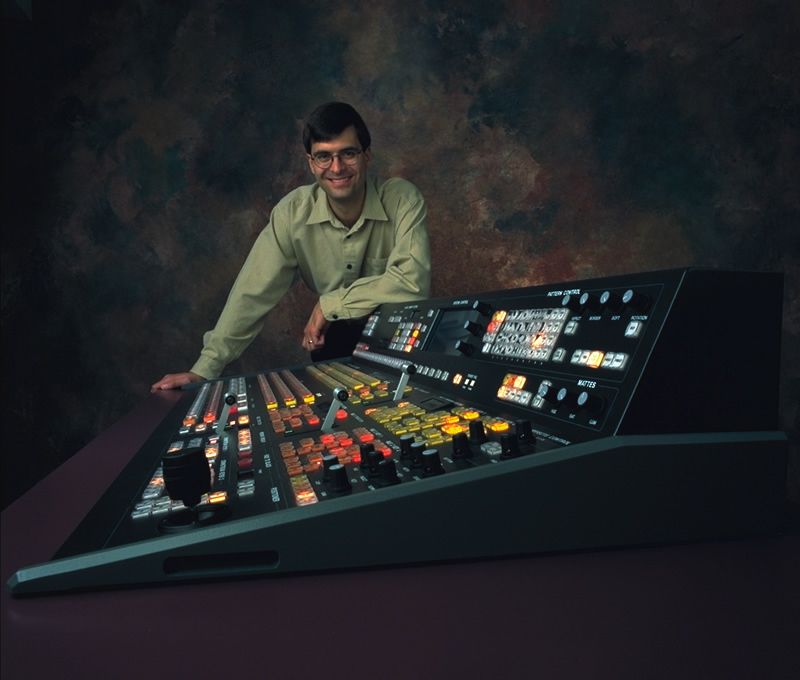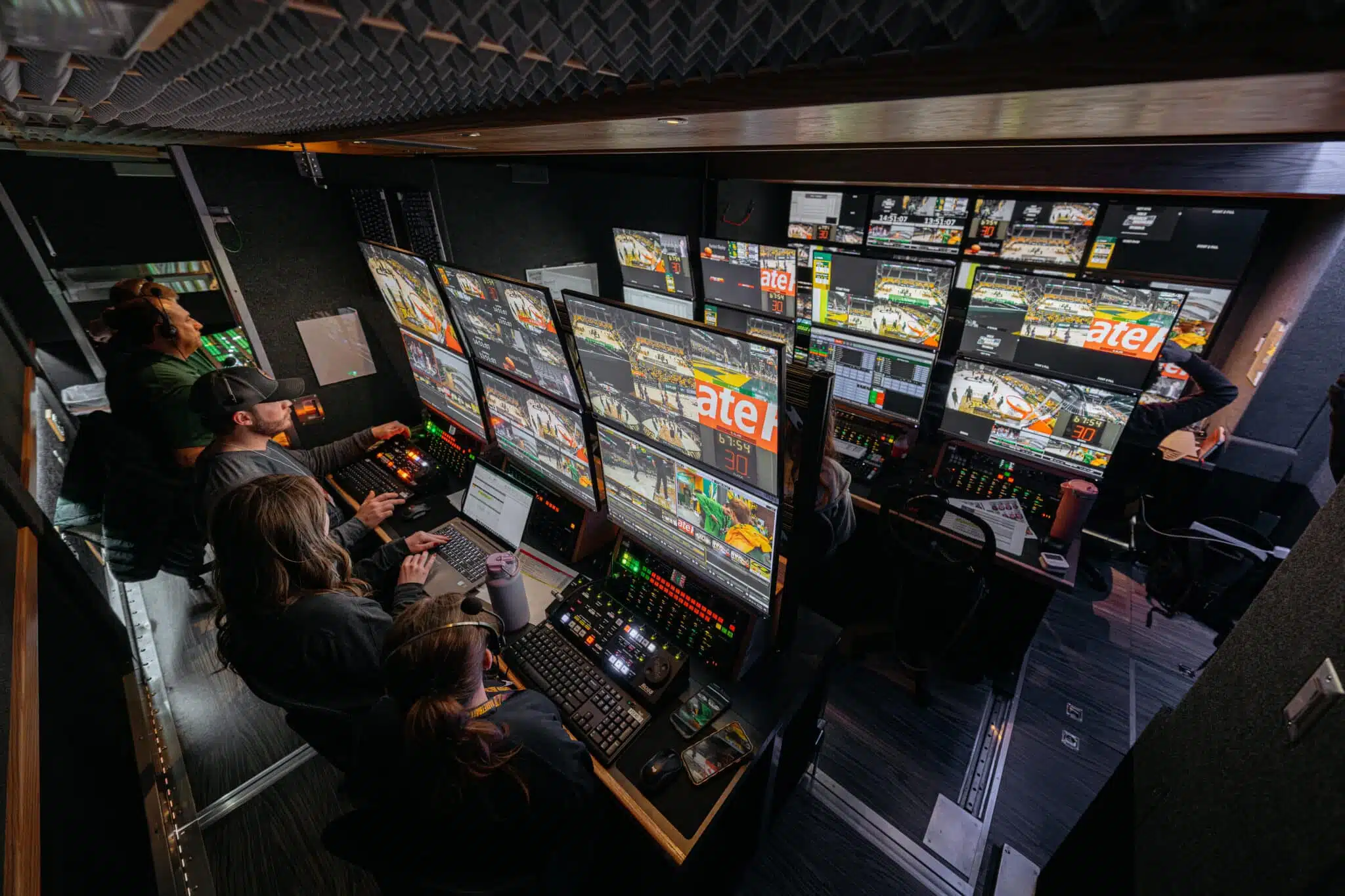Live TV doesn’t just happen. It’s shaped in real time by video switchers, the hidden tools that make broadcasts possible. Here’s everything you need to know about this secretive bit of tech.

Agility is the new benchmark
Think about the last live sports game you watched on TV. The whole experience feels like it was edited in a studio, but it’s happening in real time.
Before a replay, a stinger animation with the broadcaster’s logo flashes on screen. After a goal, the feed cuts to the team’s logo. Then it cycles through camera shots of the players, the bench, the crowd, and the celebration on the ice.
The flow between angles, graphics, and effects comes from a key piece of equipment in live production: the video production switcher — also called a video mixer or vision mixer.
What is a video switcher?
A video switcher is the tool that allows live productions to look cinematic, even as they unfold. It combines multiple video sources — cameras, graphics, or pre-recorded clips — into a single, polished feed. Operators can cut between angles, add graphics, roll replays, and apply effects instantly.
Switchers can be specialized hardware systems with control panels featuring numerous bright buttons. They can also be software solutions that run on a computer. Either way, they provide the ability to direct, edit, and enhance a broadcast in real-time. Without them, live shows would feature only a single static camera shot with no overlays or transitions.

How a video switcher works
At the most basic level, a switcher connects inputs to outputs. Inputs can include cameras, playback devices, or computers. Outputs may be monitors, projectors, or the live broadcast feed.
Thes switcher receives all the video feeds or inputs. An operator or Technical Director decides what goes on air and uses the control panel to implement it.
A multiviewer display shows all available sources side by side. Another screen shows what the audience sees live. With a button press, the operator can change cameras, trigger a replay, or overlay a graphic. They can also include digital video effects, transitions, and keyers for tasks like green screen weather reports or live lower thirds.
A Downstream Keyer (DSK) allows you to add graphics like subtitles, headlines, or logos on video. Mix Effects (M/E) banks let operators create and manage multi-layered effects and transitions simultaneously.
You can also integrate audio mixers to balance sound alongside video. Storage and playback features allow operators to roll clips or record the live program feed. Operators can program switchers with macros and sequences, allowing them to recall complex transitions with just one button press.
ISO recordings (short for isolated) enable a single camera angle to be captured separately from the program feed — a valuable tool for replays or correcting mistakes in post-production.
Hardware vs. software video mixers
Not every production has the same needs, which is why switchers come in many shapes and sizes, including both hardware and software forms.
Hardware switchers like Carbonite Ultra are the classic choice for broadcast environments. They provide numerous inputs and outputs, are highly reliable, and are relatively easy to use for trained operators. They come in a wide range of sizes and functionality, depending on your production environment and needs.
Software switchers like Carbonite Code, on the other hand, are flexible and affordable. They do not take up physical space, making them suitable for temporary or small-scale productions.
The trade-off is that they rely on the computer’s processing power. They are also limited by the availability of ports and compatibility. For certain setups, you may need additional hardware, such as GPUs or adapters.
Both approaches have their place, and many productions even combine them for maximum flexibility.

Who uses video switchers?
You’ll find video switchers anywhere a live production needs to look professional. Sports broadcasts rely on them for instant replays and scoreboard graphics. Newsrooms use them to cut between anchors, reporters, and live feeds. And you can find them in a lot of other places too:
Houses of worship also use them to enhance live-streamed services. Podcasters and streamers use them to switch between cameras and overlay graphics. At stadiums, concerts, and conferences, switchers blend different sources to deliver content on the venue’s media displays.
As content production becomes even more widespread, we’re also seeing the increasing use of live video in the corporate world, for connecting global companies, remote monitoring of facilities, remote training, and corporate events like shareholder meetings.
Choosing the right video production switcher
Finding the right switcher comes down to defining your purpose, budget, and available resources.
First, define your production needs and objectives — what’s your vision? If your production is heavy on graphics and effects, you’ll want a system with multiple keyers and a robust effects suite. If it mainly involves changing camera angles, the number of inputs and outputs will be more important.
Next, consider your budget. Hardware switchers typically come with a higher price tag, but they deliver unmatched reliability and power. Software switchers are easier on the wallet and can handle many common needs, though they may have limitations.
Finally, assess your resources. Do you have the physical space for a console? Do you have operators who can manage a professional board, or do you need something more streamlined? Do you already own cameras and other gear that need to be compatible with the switcher you choose?
Every production environment is unique. This is why switchers come in many sizes. Some are small and portable, while others are large systems made for stadiums and networks.
Need some help?
Modern switchers are more powerful and accessible than ever. But there is also more choice than ever.
If you’re unsure which switcher best suits your needs, reach out to a Ross production expert. We’ll help you find the right switcher for your production.